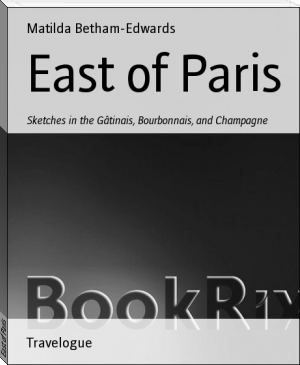East of Paris by Matilda Betham-Edwards (microsoft ebook reader TXT) 📖

- Author: Matilda Betham-Edwards
Book online «East of Paris by Matilda Betham-Edwards (microsoft ebook reader TXT) 📖». Author Matilda Betham-Edwards
Lons-le-Saulnier possesses little of interest except its Museum, rich in modern sculpture, and its quaint arcades, recalling the period of Spanish rule in Franche Comte. The excursions lying within easy reach are numerous and delightful. Foremost of these is a visit to the marvellous rock-shut valley of Baume-les-Messieurs, so called to distinguish it from Baume-les-Dames near Besancon. The descent is made on foot, and at first sight appears not only perilous but impracticable, the zigzag path being cut in almost perpendicular shelves of rock. This mountain staircase, or the "Echelle des Baumes," is not to be recommended to those afflicted with giddiness. Little sunshine reaches the heart of the gorge, yet below the turf is brilliant, a veritable islet of green threaded by a tiny river. The natural walls shutting us in have a majestic aspect, but playful and musical is the Seille as it ripples at our feet. Travellers of an adventuresome turn can explore the stalactite caverns and other marvels around; not the least of these is a tiny lake, the depth of which has never been sounded. For half-a-mile the valley winds towards the straggling village of Baume, and there the marvels abruptly end.
Nothing finer in the way of scenery is to be found throughout eastern France. In the ancient Abbey Church are two masterpieces, a retable in carved wood and a tomb ornamented with exquisite statuettes.
CHAPTER XIX.
NANCY.
It is a pleasant six hours' journey from Dijon via Chalindrey to Nancy. We pass the little village of Gemeaux, in which amongst French friends I have spent so many happy days.
From the railway we catch sight of the monticule crowned by an obelisk; surmounting the vine-clad slopes, we also obtain a glimpse of its "Ormes de Sully," or group of magnificent elms, one of many in France supposed to have been planted by the great Sully. Since my first acquaintance with this neighbourhood, more than twenty years ago, the aspect of the country hereabouts has in no small degree changed. Hop gardens in many spots have replaced vineyards, owing to the devastation of the phylloxera. It was in the last years of the third Empire that the inhabitants of Roquemaure on the Rhone found their vines mysteriously withering.
A little later the left bank was attacked, and about the same time the famous brandy producing region of Cognac in the Charente showed similar symptoms. The cause of the mischief, the terrible Phylloxera devastatrix, was brought to light in 1868. This tiny insect is hardly visible to the naked eye, yet so formed by Nature as to be a wholesale engine of destruction, its phenomenal productiveness being no less fatal than its equally phenomenal powers of locomotion. One of these tiny parasites alone propagates at the rate of millions of eggs in a season, a thousand alone sufficing to destroy two acres and a half of vineyard. As formidable as this terrible fertility is the speed of the insect's wings or rather sails according extraordinary ease of movement. A gust of wind, a mere breath of air, and like a grain of dust or a tuft of thistledown, this germ of destruction is borne whither chance directs, to the certain ruin of any vineyard on which it lights. The havoc spread with terrible rapidity. From every vine- growing region of France arose cries of consternation. Within the space of a few years hundreds of thousands of acres were hopelessly blighted. In 1878 the invader was first noticed at Meursault in Burgundy; a few days later it appeared in the Botanical Gardens of Dijon. The cost of replanting vineyards with American stocks is so heavy, viz.: twenty pounds per hectare, that even many rich vintagers have preferred to cultivate other crops. Some owners have sold their lands outright.
On quitting Is-sur-Tille we enter the so-called Plat de Langres, or richly cultivated plains stretching between that town and Toul, in the Department of the Meurthe and Moselle.
With the almost sudden change of landscape--woods, winding rivers, and hayfields in which peasants are getting in their autumn crop, literally mauve-tinted from the profusion of autumn crocuses--we encounter sharp contrasts, the events of 1870-1 changing the French frontier, necessitating the transformation we now behold--once quiet, old-world towns now wearing the aspect of a vast camp, everywhere to be seen military defences on a wholly inconceivable scale. It is comforting to hear from the lips of those who should know, that at the present time war is impossible, the engines of warfare being so tremendous that the result of a conflict would be simply annihilation on both sides. After ten years' absence, and in spite of radical changes, the elegant, exquisitely kept town of Nancy appears little altered to me. The ancient capital of Lorraine is now one of the largest garrisons on the eastern frontier, but the military aspect is not too obtrusive. Except for the perpetual roll of the heavy artillery waggons and perpetual sight of the red pantalon, we are apt to forget the present position of Nancy from a strategic point of view.
Other changes are pleasanter to dwell on. The Facultes, or schools of medicine, science, and law, removed hither from Strasburg after the annexation, have immensely increased the intellectual status of Nancy, whilst from the commercial and industrial side the advance has been no less. Its population has doubled since the events of 1870-1, and is constantly increasing. Why so few English travellers visit this dainty and attractive little capital is not easy to explain. More interesting even than the artistic and historic collections of Nancy is the celebrated School of Forestry. Formerly a few young Englishmen were out-students of this school, but since the study had been made accessible at home the foreign element at the time of my visit, consisted of a few Roumanians, sent by their Government. The Ecole Forestiere, courteously shown to visitors, was founded sixty years ago and is conducted on almost a military system. Only twenty-four students are received annually, and these must have passed severe examinations either at the Ecole Agronomique of Paris, or at the Ecole Polytechnique. The staff consists of a director and six professors, all paid by the State. Two or three years form the curriculum and successful students are sure of obtaining good Government appointments. Forestry being a most important service, every branch of natural science connected with the preservation of forests, and afforesting is taught, the school collections forming a most interesting and wholly unique museum. Here we see, exquisitely arranged as books on library shelves, specimens of wood of all countries, whilst elsewhere sections from the tiniest to the gigantic stems of America. Very instructive, too, are the models of those regions in France already afforested, and of those undergoing the process; we also see the system by means of which the soil is so consolidated as to render plantation possible, namely, the arresting of mountain torrents by dams and barrages. In the Dauphine, and French Alps generally, many denuded tracks are in course of transformation, the expense being partly borne by the State and partly by the communes. It is impossible to over-estimate the importance of such works, alike from a climatic, economic, and hygienic point of view. The extensive eucalyptus plantations in Algeria, teach us the value of afforesting, vast tracks having been thereby rendered healthful and cultivable.
A strikingly beautiful city, sad of aspect withal, is this ancient capital of Lorraine, ever wearing half mourning, as it seems, for the loss of its sister Alsace.
Unforgettable is the glimpse of the Place Stanislas, with its bronze gates, fountains, and statue, worthy of a great capital; of the beautiful figure of Duke Antonio of Lorraine on horseback, under an archway of flamboyant Gothic; of the Ducal Palace and its airy colonnade; lastly, of the picturesque old city gate, the Porte de la Crafie, one of the most striking monuments of the kind in France.
All these things may be glanced at in an hour, but in order to enjoy Nancy thoroughly, a day or two should be devoted to it, and creature comforts are to be had in the hotels.
In the Ducal Palace are shown the rich tapestries found in the tent of Charles le Temeraire after his defeat before Nancy, and other relics of that Haroun-al-Raschid of his epoch, who bivouacked off gold and silver plate, and wore on the battle-field diamonds worth half a million. The cenotaphs of the Dukes of Lorraine are in a little church outside the town--the _chapelle ronde_, as the splendid little mausoleum is designated, its imposing monuments of black marble and richly-decorated octagonal dome, making up a solemn and beautiful whole. Graceful and beautiful also are the monuments in the church itself, and those of another church, des Cordeliers, close to the Ducal Palace.
Nancy is especially rich in monumental sculpture, but it is in the cathedral that we are enchanted by the marble statues of the four doctors of the church--St. Augustine, St. Gregoire, St. Leon, and St. Jerome. These are the work of Nicholas Drouin, a native of the town, and formerly ornamented a tomb in the church of the Cordeliers just mentioned. The physiognomy, expression, and pose of St. Augustine are well worthy of a sculptor's closest study, but it is rather as a whole than in detail that this exquisite statue delights the ordinary observer.
All four sculptures are noble works of art; the beautiful, dignified figure of St. Augustine somehow takes strongest hold of the imagination. We would fain return to it again and again, as indeed we would fain return to all else we have seen in the fascinating city of Nancy.
From Nancy, by way of Epinal, we may easily reach the heart of the Vosges.
CHAPTER XX.
IN GERMANISED LORRAINE.
At the railway station of Nancy, I was met by a French family party, my hosts to be in a chateau on the other side of the French frontier.
We had jogged on pleasantly enough for about half an hour, when the gentlemen of the party, with (to me) perplexing smiles, briskly folded their newspapers and consigned them, not to their pockets or rugs, but to their ladies, by whom the journals were secreted in underskirts.
"We are approaching the frontier," said Madame to me.
I afterwards learned that only one or two French newspapers are allowed to circulate in the annexed provinces, the _Temps_ and others, the names of which I forget; for the first and second offence of smuggling prohibited newspapers, the offender is subjected to a reprimand, the third offence is punished by a fine, the fourth involves imprisonment. Now, as all of us know who have lived in France, the _Figaro_ is a veritable necessity to the better-off classes in France, the _Times_ to John Bull not more so. Similarly, to the peasant and the artisan, the _Petit Journal_ takes the place of the half-penny newspaper in England. This deprivation is cruelly felt, and is part of the system introduced by William II.
Custom-house dues are at all times vexatious, but on the French- Prussian frontier they are so arranged as to provoke patriotic feeling. It may seem a foolish fancy for French folks, German subjects of the Kaiser, to prefer French soap and stationery, yet what more natural than the purchase of such things when within easy reach? Thus, on alighting at the frontier, not only were trunks and baskets turned out, we were all eyed from head to foot suspiciously. My hosts' newspapers were not unearthed, certainly; perhaps





Comments (0)